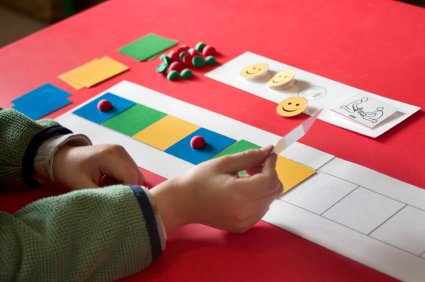Applied Behaviour Analysis, commonly known as ‘ABA’, is a systematic method of used to support and/or improve behaviour to a meaningful degree. An ABA program is a systematic teaching approach that uses methods of behavioural psychology including discrete trial and positive reinforcement to analyse information and behaviour, in order to systematically teach new skills.
ABA therapy techniques, to date, is the only treatment consistently validated by scientific research. Many children in these studies were able to develop communicative speech and improved social relatedness was visible in 90% of those treated (Lovaas, 1987; McEachin, Smith, & Lovaas, 1993). More importantly, every child can benefit from ABA through systematically learning new skills and reducing challenging behaviours.
HOW CAN I USE ABA TO TEACH MY CHILD?
Breaking Skills Down & Simplifying Learning – All tasks are easily learnt if they are broken down into a series of small steps that are easier to grasp. Simple skills such as learning to clap hands or giving a high 5 to complex skills such as learning to take turns or having a conversation are broken down into a series of steps. Each step is taught by giving your child an opportunity to practice the step over and over again until your child masters the step before moving on to a more difficult step, and ultimately using it in everyday life.
Providing Positive Reinforcement & Motivating a Child – Learning is always made easier if your child (i) motivated and (ii) learning is fun. To encourage situations in which your child wants to participate in learning, identify activities or rewards that your child really enjoys and utilise these activities or rewards to motivate your child during teaching (positive reinforcement). Rewards, also known as “reinforcers” can include anything a child shows interest towards from a favourite toy, to snacks, hugs, spins in the air, or even praises. When a child successfully learns something new, the reward or “reinforcer” is given to your child. Rewards, praises, and encoruagements can also be provided when a child first learns something new as an encouragement and motivation simply for trying. That way, success is maximised; making learning fun and motivating.
Providing Sufficient Practice – As compared to a typical child, children with autism often need more time and much more practice in attaining a new skill. Create plenty of opportunities to repeat and re-repeat practice opportunities throughout your child’s day so that he/she becomes an “expert” at it.
BUILDING LANGUAGE
Building Early Language – With some children, building early expressive language is relatively challenging. Increasing a child’s expressive language can aid in increasing a child’s socialisation and play with other peers. When teaching a child to build early language, here are a few tips to remember:
- Stick to one language – Although we live in a multilingual society, try to only utilise one language of communication. Select a language you’re most comfortable with and is most often used by your family and friends; and communicate with your child in that language. Communicating with your child in various languages may come across as confusing to him/ her and make expressive language more challenging for your child.
- Do not ask questions – When children play begin playing together, it inevitably involves language. If you notice, children do not typically ask many questions during play but they do have language that “script” out their play. Try commenting, labelling, or even narrating ongoing activities and actions instead of asking continuous questions. One of the down sides of asking questions is that it may eventually come across as demanding some sort of response or interaction from him/her and deter your child from attempting sound(s) and language.
- Use short phrases – Language is a complex skill that is challenging for children with autism. Like any complex skill, beginning with simple steps works best and makes learning easier. Try consistently using short, simple phrases that are easy for your child to understand, learn, and imitate. Make sure that everyone consistently uses similar phrases. The idea is to continue providing plenty of consistent practice for your child to expand his/her vocabulary.
For more detailed explanations/ tips/ ideas on how to teach your child, you can refer to our blog at www.autismmalaysia.com
REFERENCES:
Early Autism Project Malaysia, EAP Malaysia, Kuala Lumpur, Malaysia.
Lovaas, O. I. (1987). Behavioral treatment and normal educational and intellectual functioning in young autistic children. Journal of consulting and clinical psychology, 55(1), 3.
McEachin, J. J., Smith, T. & Lovaas, O. I. (1993). Long-term outcome for children with autism who received early intensive behavioural treatment. American Journal of Mental Retardation, 97(4), 359-372.


Comments
2 responses to “Autism Awareness Month : How to teach a child with autism?”
Assalammualaikum.
Hai doc. Saya nani. Saya ada anak berumur 3 bulan. Dia nampak active. Dan sangat suka berdiri. Kepala,tulang belakang dan kaki nampak kuat. saya try walker nampak dia selesa. Adakah boleh saga teruskan?atau ia akan menganggu perkembangan bayi saya. Saya risau kerana dari blog2 yang saya baca. kebanyakan komen negative dan hanya start kan anak mereka pada umur 5 bulan keatas.
Saya harap doc dapat memberi pencerahan keatas hal ini.
Saya mempunyai anak lelaki berusia 5thn yg mengalami masalah lambat bercakap. Baru2 INI anak Saya ada menjalani pembedahan telinga Dan tekak. Selepas pembedahan tersebut Saya dapati ada perkembangan positif dimana anak saya dapat menyebut perkatan2 baru Dan membuat ayat 4 patah perkatan walaupun adakala sebutannyer kurang jelas.Selain drpd itu anak Saya juga mengalami masalah daya tumpuan ditadika dimana anak Saya tidak dapat memberi
tumpuan sepenuhnyer didalam kelas Dan ini menyebabkan pembelajaran anak Saya Sgt lambat berbanding rakan sebaya yg lain.Disini sy ingin bertanya bagaimanakh caranyer sy dpt membantu agar dapat mempercepatkan pertuturan Dan mengatasi masalah daya tumpuan anak Saya?